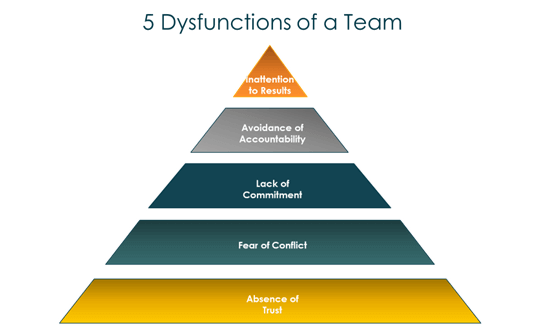“I didn’t push back or challenge, because I don’t want to rock the boat”.
In our leadership and culture work with organisations, those words send a shiver down my spine. What it often means is that people avoid saying what they really think, meetings run smoothly on the surface with very little real debate, and decisions get made without much challenge. It feels harmonious… until cracks start to appear.
The truth is, avoiding conflict doesn’t keep the peace, it actually stores up tension, slows progress, and weakens trust. And the costs are real.
In the UK alone, workplace conflict costs employers £28.5 billion every year – around £1,000 per employee [Warwick University, 2021].
Why We Avoid Conflict
Despite countless leadership books and relationship experts urging us to “have the difficult conversations,” many of us treat conflict like the office fridge: we know there’s something unpleasant in there, but we hope if we ignore it long enough, it’ll go away, or someone else will deal with it.
At work, most people sidestep conflict for one or more of the following reasons:
- Fear of damaging relationships. We worry it will lead to resentment or tension.
- Desire to be liked. We’re human and avoid saying things that might make us unpopular.
- Lack of skills or confidence. We simply don’t know how to navigate difficult conversations. (it’s hard enough in our personal lives without trying to navigate them at work!)
- Past negative experiences. Perhaps we associate conflict with aggression or personal attacks.
- Organisational norms. There are many cultures where harmony is prized over honesty.
- Personal conditioning. Like many others, I was brought up with the mantra “if you can’t say anything nice, don’t say anything at all.” And we’ve translated that into some unhelpful behaviours which don’t serve us.
Ironically, avoiding conflict, often breeds the very problems, such as tension, frustration and mistrust, that we were hoping to avoid.
Why Healthy Conflict is Good for Culture
Patrick Lencioni’s Five Dysfunctions of a Team places fear of conflict just above absence of trust in his pyramid of what undermines high performance in teams. Without trust, people don’t feel they can speak openly; without healthy conflict, they can’t engage in the robust debate needed for the best decisions.
When conflict is embraced in a healthy way, it:
- Leads to better decisions, because ideas are aired, tested, and improved.
- Strengthens trust; people feel safe to disagree without fear of backlash.
- Prevents groupthink. When we challenge assumptions, we can uncover blind spots.
- Builds resilience, so that teams become better at handling ambiguity and change.
- Drives commitment. Even if we don’t agree, once everyone’s views are heard, decisions gain stronger buy-in.

In The Five Dysfunctions of a Team, fear of conflict sits just above absence of trust in the hierarchy. Without trust, people won’t speak openly; without healthy conflict, teams end up in artificial harmony with everyone nodding along in meetings while real concerns and better ideas stay buried. When leaders build trust and encourage constructive challenge, conflict becomes a tool for clarity, innovation, and stronger commitment, rather than a source of division.
Managing Conflict Well
Healthy conflict doesn’t mean we give full rein to heated shouting matches or even allow team members to compete to try to “win” arguments; it’s about constructive debate and respectful challenge.
Some key practices you can include to positively manage conflict include:
- Build psychological safety first. People need to know that speaking up won’t cost them their reputation or relationships. If you are leading a team, make sure that you are creating the right environment where team members can be respectfully honest and open without consequences.
- Separate people from the problem. Make sure you are focusing on issues, not personalities. Is the issue the trigger or are we misinterpreting someone’s intentions, because we have “previous history” with them?
- Encourage candour and curiosity. Ask questions rather than making statements, ask “What’s your perspective on this?” and genuinely listen to understand, rather than stating “I don’t agree with you” or “you’re wrong.”
- Agree some ground rules for debating. For example, no interrupting, challenge ideas, not people, evidence rather than assumption-based, assume positive intent. A nice reframe can be “debate to explore ideas, not to win.”
- Be a role model. Show you welcome discussion and challenge by thanking people who disagree with you. “That’s a really interesting point, thank you.” “I hadn’t thought about it from that angle, so I really appreciate you helping me to think differently.”
- Debrief afterwards. Reflect on what went well and what could be improved for next time. See potential conflict discussions as an opportunity to learn and grow together, developing better skills.
Case Study: From Silence to Success
When a leadership team at a manufacturing site met each month, their meetings were oddly calm, almost perfunctory. Everyone agreed quickly, rarely asked probing questions, committed to actions and timescales and decisions were made without much discussion. On the surface, they said they were a highly aligned group, but outputs and results told a different story. Actions often weren’t completed on time, projects stalled, and duplicated work was common.
During a workshop, we explored the culture and how they worked as a team. They were stuck in “artificial harmony”, just as Lencioni highlights in his book, the Five Dysfunctions of a Team. They admitted they avoided challenging each other because they didn’t want to “rock the boat” or “make things personal.”
The leader led a shift:
- They agreed on ground rules for respectful challenge.
- They began inviting pushback in meetings, often starting with “Who sees this differently?”
- They introduced some direct questions, “How realistic are these timescales, with the other projects we have on?”.
- They reviewed major decisions with the mindset that conflict is the price of better thinking.
Within three months, the tone in meetings had changed. There were definitely more heated debates, but it also felt more relaxed with open discussions and more robust decisions. Project consistency and completion improved, and the team reported higher trust scores in their pulse survey.
The lesson? Conflict didn’t break the team; it made them stronger.
The Bottom Line
Conflict is not the enemy of a strong culture; silence is. When teams learn to replace avoidance with open, respectful challenge, they unlock better thinking, deeper trust, and faster progress. The best leaders don’t fear disagreement; they invite it, shape it, and use it as fuel for collective success.

